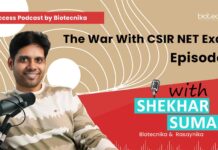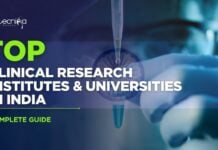Top 10 Bio-scientific Discoveries Of The Year 2018
Voice of Biotecnika – Episode No: 36
Imagine if ancient humans never thought of venturing out of Africa, where would have been the human civilization today?
Maybe still surviving in Africa, with limited knowledge of the outer world and limited advancement, like the uncontacted indigenous tribes of rainforest. In fact, the extensive variation among human, their way of life, beliefs, understanding, and utilization of nature so on and so forth would have never developed.
All these happened just because of early human thought of exploring. Exploration of unknown creates a need which can be fulfilled by metamorphic inventions and the outcome of explorations brings in fascinating discoveries.
Thus, the journey of unknown started eons ago, triggered the invisible cascade of discoveries for eternity.
Today we will look into those discoveries which are of importance presently, “Top 10 Bio-scientific discoveries of 2018” presented by Biotecnika team member Sunita.
2018 saw many breakthrough discoveries in the field of science right from discovery of new giant dinosaur fossils, ghost particle, rare ice VII crystals, new organ to first ancestral cell. All these discoveries have added some new information to the existing knowledge and can
pave the way for future discoveries. Among those many interesting discoveries, we are presenting today Top 10 Bio-scientific Discoveries of the year 2018.Listen to Voice of Biotecnika Podcast on Soundcloud
Table of Contents
1. CRISPR Baby
Number 1 is the most sensational findings of the year -CRISPR baby. With the advent of GMOs people started to imagine about the future of RDT in form of Designer Babies. In fact, the world has been speculating long the probability of such research going on secretly somewhere. These speculations came to be true when prior to Second International Summit on Human Genome Editing, news broke about Dr. He Jiankui creating the first-ever gene edited babies – twin girls Lulu and Nana.
Dr. He performed CRISPR mediated gene editing in human embryos to make them HIV resistant. The gene which was targeted was CCR5, a mutant version already found in some Northern Europe population. But the news though remarkable, shocked the world and has been thoroughly criticized for its inappropriate execution, lack of foresight on the part of the researcher in terms of long-term effects and most important concern is the effectiveness in HIV resistance. Right now, it is difficult to say whether the research is successful or failure, but whatever it be the consequences are going to be far fetched.
2. Successful cloning of Monkeys
Next in the line is number 2, first ever cloning of monkeys- the macaques. A postdoctoral fellow of the Chinese Academy of Sciences, Zhen Liu has successfully created clones of primates or the first. However, prior to this finding, in 1999 researchers had cloned rhesus macaques by early-stage embryo splitting, but the present research employs a different technique called somatic cell nuclear transfer.
If we go back to 1996, Dolly- the famous cloned sheep was created using the same technique. It is quite advantageous compared to embryo splitting as theoretically an indefinite number of clones can be created by this method from a single donor. This is the first time efforts of Chinese researchers have yielded in successful clones of non-human primates in form of the birth of two female macaques named as Zhong Zhong and Hua Hua. This discovery again has the potential for both progress and controversies. For Biomedical research, this can be a boon but equally terrifying is the ethical concern over cloning of non-primates just for research purpose. And most importantly will it not fuel the idea of possible human cloning next? Think over it.
3. Space travel can change gene expression
Number 3 position is for the famous Twin paradox of relativity. So, according to Einstein’s relativity – one of twin moving at the speed of light in space towards a distant star will remain younger compared to its other twin who remains on earth. So, space travel makes the twins age differently?
Well in a unique study published by NASA on identical twin Kelly brothers – Scott and Mark, reports show that may not age differently, but space travel can change many biological processes. Scott Kelly spent one year in International Space Station and during this time his “Space genes” were activated which was not found in Mark. After returning to earth 93% of Scott’s gene expression returned to a normal level, except 7% even after 2 years of space travel. Along with it, other differences observed were lengthening of telomeres, changes in collagen, bone formation, blood clotting, and hyperactive immune system. This study gives insight into the effect of space travel on human, which can help in planning future space expeditions.
4. Reversed Aging in Mice
Whether space travel can affect aging or not, but for sure the next, number 4 finding on aging can put up a broad smile on many faces i.e reversed aging in mice. Dr. Leonard Guarente and Dr. David Sinclair and their team made an interesting discovery – the mechanism behind vascular aging and muscle decline in mice. Both the conditions are associated with aging leading to morbidity and mortality. Treatment of mouse with NAD+ precursors – NMN or nicotinamide mononucleotide, activated the enzyme sirtuin deacetylases which is gradually lost during aging.
This protein activation reverses the signs of aging by promoting neovascularization, increasing blood supply to tissues and organs, and reducing cell death. These experimental mice were found to almost 50-80% better in performing physical exercise compared to control. Altogether the present discovery has immense potential in enhancing the stamina, performance, and endurance of an organism. Surely this has opened many vistas for further research, so having immortal life may not remain as a figment of imagination or a mythical concept of long.
5. New Organ – Interstitium
In number 5 is the most amazing Bio-scientific discovery – a new organ, an organ which has so far evaded physicians – the interstitium. With the advent of new imaging technique, Probe-based confocal laser endomicroscopy helped Dr. Neil Theise and his team of New York University School of Medicine to identify the new organ. It appeared as extensive interconnected fluid-filled spaces in connective tissue. These finally drain into the lymphatic system and are supported by thick collagen bundles and associated fibroblast. In fact they are so abundant that found almost throughout – below the skin, submucosa of entire peri-bronchial and arterial soft tissue, urinary tract, gastrointestinal tract, and fascia. This is a significant finding in terms of completing our understanding about working of the human body and conditions like fibrosis, edema and cancer metastasis.
6. Treatment for blindness
Likewise, many important advancements in medicine and treatment have been achieved in the year 2018. So, the next number 6 discovery is Cure for blindness. Age-related macular degeneration (AMD) is caused by malfunctioning of a layer of cells underlying photoreceptors in the macula known as retinal pigment epithelium (RPE). RPE are supportive cells which help to maintain photoreceptors as they stop working, photoreceptors die leading to blindness. Majority of the cases of blindness occur due to AMD and as such, there is paucity for a treatment. Many researchers have targeted the stem cells for the treatment purpose. In the clinical trial, 2 people with the condition of AMD, received stem cell patches in the damaged portion of the retina. The stem cells restored the RPE cells and the patients gradually regained the ability to read and visualize faces. The outcome of the trials is very promising and has the potential to cure blindness caused by ADM.
7. Artificial T Cell
Stem cell therapy has been extensively used in this year for Sickle cell anemia, Multiple Sclerosis, Cancer, Alzheimer’s and many more diseases, but another extraordinary development which can be included at Number 7 is – Development of Artificial T cell. Sounds unbelievable but yes, it is possible. Researchers at UCLA have created a synthetic T cell which mimics the shape, size and basic functions of T cell. The technology used for this is microfluidics creating microparticles of alginate whose elasticity was adjusted using Ca ions ultimately forging the T cell in terms of physical appearance. Appropriate biological activity was imparted by coating the T cell with phospholipids and bio-conjugating CD4 molecules. These surface modifications converted it into a functional T cell. Development of artificial T cell is a key step towards a better understanding of the immune system, ability to design other immune cells and use them as a treatment for diseases like autoimmunity, hypersensitivity, and cancer.
8. Memory Transplantation
At number 8 is the discovery which made headlines all over the world, Memory Transplantation. Yes, it sounds almost like the famous Harry Potter series memory extraction where a single memory can be isolated and stored in a bottle or even viewed in a pensive. May not so much vivid, but the research conducted by Dr. David Glanzman has provided a definite clue to the mechanism of memory development. According to Dr. Glanzman, memories are encoded in RNA molecules.
To prove this, he triggered a defensive response in sea hares, by first sensitizing it with a series of electric shock followed prodding in spout known as a siphon. The defensive response was a contraction of gills. Next step was RNA isolation from these snails, which was then injected into snails who were never exposed to the same experience. Those recipient snails were now found to be sensitized and showed the same defensive response on the receiving the trigger of prodding in the siphon. This finding though sheds a light on some part of the mechanism, yet other researchers are skeptical to accept it. Maybe more research in this direction can give us a better understanding until then we can just speculate.
9. But for sure now humans can think of migrating to other plants without worry about food?
Why- that is the number 9 discovery – Agriculture without earth, daylight and pesticide that also in Antarctica. Scientist at Germany’s Neumayer Station III in Antarctica achieved this difficult task by designing high-tech greenhouses. Even in the subzero temperature of -20° C, the greenhouses were able to maintain ambient conditions for the growth of different vegetables. The researchers were able to harvest 3.6 kg of salad greens, 18 cucumbers, and 70 radishes and in the future hope to achieve a yield of 4-5 kg of fruit and vegetables per week. Similar research is being conducted by NASA in space stations. So, we hope one day to grow vegetables on Mars just like the movie Martian.
10. Lab-grown Meat
And number 10 Bio-scientific discovery is Growing meat in Labs to remove animal cruelty for food. Many labs are working on it, but there is a barrier, i.e. still for growing the cells bovine serum is required which again comes from animal slaughter. A Dutch startup, Meatable has solved the problem by using stem cells harvested from the umbilical cord and developing a proprietary technique which can coax these stem cells to differentiate into muscle and fats cells. Altogether a perfect recipe, for meat formulation in lab minus any cruelty to any animal. So, in the near future, you can order a lab-grown meat burger or sausage but look out for the price tag.
Those were some of the Top 10 Bio-scientific Discoveries of 2019. Lets us see what this year 2019 has in store for us. Till then goodbye.
 from IIT Kharagpur and is experienced in subjects like Cell Biology and Immunology. Being a passionate educator, Dr. Sunita keeps herself up-to-date with current research and shares the same with her students through after lecture activities like Pictionary, discussions, etc. She encourages each one to reach their full potential and has been an influential role model. In this Podcats she throws light on the topic – Top 10 Bio-scientific Discoveries Of The Year 2018.
from IIT Kharagpur and is experienced in subjects like Cell Biology and Immunology. Being a passionate educator, Dr. Sunita keeps herself up-to-date with current research and shares the same with her students through after lecture activities like Pictionary, discussions, etc. She encourages each one to reach their full potential and has been an influential role model. In this Podcats she throws light on the topic – Top 10 Bio-scientific Discoveries Of The Year 2018. 







































